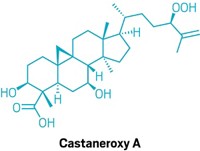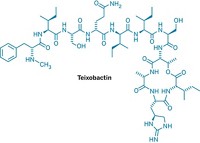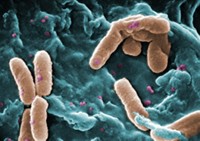Advertisement
Grab your lab coat. Let's get started
Welcome!
Welcome!
Create an account below to get 6 C&EN articles per month, receive newsletters and more - all free.
It seems this is your first time logging in online. Please enter the following information to continue.
As an ACS member you automatically get access to this site. All we need is few more details to create your reading experience.
Not you? Sign in with a different account.
Not you? Sign in with a different account.
ERROR 1
ERROR 1
ERROR 2
ERROR 2
ERROR 2
ERROR 2
ERROR 2
Password and Confirm password must match.
If you have an ACS member number, please enter it here so we can link this account to your membership. (optional)
ERROR 2
ACS values your privacy. By submitting your information, you are gaining access to C&EN and subscribing to our weekly newsletter. We use the information you provide to make your reading experience better, and we will never sell your data to third party members.
Antibiotics
Common allergy drug makes resistant bacteria vulnerable to antibiotics
Over-the-counter antihistamine loratadine busts bacterial biofilms and helps oxacillin to kill antibiotic-resistant Staphylococcus aureus in the lab
by Jyoti Madhusoodanan, special to C&EN
June 12, 2019
| A version of this story appeared in
Volume 97, Issue 24
The common antihistamine loratadine—the active ingredient in over-the-counter medications such as Claritin, Alerclear, and Alavert—makes some species of antibiotic-resistant bacteria susceptible to antibiotics in lab experiments (ACS Infect Dis. 2019, DOI: 10.1021/acsinfecdis.9b00096). Loratadine alone also breaks up bacterial biofilms, tight-knit microbial communities that form on implants and catheters and make resistance worse. The results offer a new route to developing drugs for these hard-to-treat infections, the researchers say.
To cope with the rise of these stubborn bacterial strains, clinicians often combine different antibiotics or prescribe them along with drugs that help prevent bacterial enzymes from degrading antibiotics. But for now, there are no drugs that increase bacterial susceptibility to existing antibiotics. “It’s totally unexpected to see an antihistamine compound have this effect,” says chemist Steven D. Townsend of Vanderbilt University, who was not involved in the study. He adds that if the findings hold up in clinical studies, loratadine’s antibacterial activities “could be really powerful.”
Study authors Meghan S. Blackledge and Heather B. Miller of High Point University were on the hunt for existing drugs that could help counter antibiotic resistance. Last year, they reported that one class of antidepressants increased the sensitivity of methicillin-resistant Staphylococcus aureus (MRSA) to antibiotics, but the high doses required would be toxic to patients. Then, while preparing to give an organic chemistry lecture, Blackledge stumbled across the structure of loratadine—which looked surprisingly similar to the antidepressants they had studied.
The researchers cultured varieties of S. aureus and S. epidermidis, including standard laboratory strains and ones isolated from hospital-acquired or community-acquired infections. They treated the bacteria with a common antibiotic, oxacillin, in the presence of loratadine and desloratadine, a bioactive metabolite of the drug. When treated with loratadine, S. aureusstrains were 8 to 500 times as sensitive to the antibiotic. Desloratadine did not affect S. aureus susceptibility, and neither compound had any effect on S. epidermidis.
Antibiotic resistance and biofilm formation are regulated by similar genetic mechanisms. Biofilms enhance drug resistance and are the main cause of catheter-associated infections. When the researchers tested the effects of applying the antihistamines to bacteria in culture, they found that loratadine blocked biofilm formation and broke up preformed biofilms of all S. aureus strains and of some S. epidermidis strains tested.
The team then sought loratadine’s targets. Both microbes carry a gene named stk whose protein triggers the synthesis of antibiotic-blocking enzymes. Mutant S. aureus strains that lack stk were not made more sensitive to oxacillin by loratadine, suggesting the gene’s product could be loratadine’s target.
“There aren’t any compounds in the clinic that disarm antibiotic-resistance mechanisms, and there’s nothing that targets the biofilm machinery,” says medicinal chemist Robert W. Huigens of the University of Florida, who was not involved with the study. The new work offers a route to possibly repurposing an existing compound and also reveals a new bacterial target, “allowing us to come up with additional molecules that may be therapeutic agents.”
Further studies in animal models will be needed to see if loratadine is effective against infections. Moreover, the authors add that loratadine—taken as a pill for allergies—is converted into desloratadine in the body, and the latter was ineffective in their experiments. “Loratadine could have applications as a topical ointment on burns or wounds,” where it wouldn’t be metabolized, Blackledge says.





Join the conversation
Contact the reporter
Submit a Letter to the Editor for publication
Engage with us on Twitter